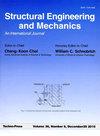高速行驶条件下车桥相互作用的研究模型
IF 3
4区 工程技术
Q2 ENGINEERING, CIVIL
引用次数: 3
摘要
20年来,轨道车辆的速度越来越高,中国于2020年10月推出了一款时速可达400公里的高速列车原型。在如此高的速度下,以前在通用计算模型中被忽略的轮轨力项目应该重新评估和考虑。针对这一问题,提出了一种研究高速行驶时车桥相互作用的新模型。与普通模型相比,新模型更加准确和适用,因为它额外考虑了二阶拟惯性力效应,其建模平衡位置基于桥梁的初始变形曲线,其中可以包括温度、预拱、收缩和蠕变变形以及桥墩不均匀沉降等的影响。以5km/h为速度区间,研究了经典车桥系统在5km/h至400km/h速度范围内的动力响应。结果表明,忽略二阶拟惯性力会低估车桥系统的动力响应,使高速铁路桥梁结构设计变得不安全。本文章由计算机程序翻译,如有差异,请以英文原文为准。
A model for investigating vehicle-bridge interaction under high moving speed
The speed of rail vehicles become higher and higher over two decades, and China has unveiled a prototype highspeed train in October 2020 that has been able to reach 400 km/h. At such high speeds, wheel-rail force items that had previously been ignored in common computational model should be reevaluated and reconsidered. Aiming at this problem, a new model for investigating the vehicle-bridge interaction at high moving speed is proposed. Comparing with the common model, the new model was more accurate and applicable, because it additionally considers the second-order pseudo-inertia forces effect and its modeling equilibrium position was based on the initial deformed curve of bridge, which could include the influences of temperature, pre-camber, shrinkage and creep deformation, and pier uneven settlement, etc. Taking 5 km/h as the speed interval, the dynamic responses of the classical vehicle-bridge system in the speed range of 5 km/h to 400 km/h are studied. The results show that ignoring the second-order pseudo-inertia force will underestimate the dynamic response of vehicle-bridge system and make the high-speed railway bridge structure design unsafe.
求助全文
通过发布文献求助,成功后即可免费获取论文全文。
去求助
来源期刊

Structural Engineering and Mechanics
工程技术-工程:机械
CiteScore
3.80
自引率
18.20%
发文量
0
审稿时长
11 months
期刊介绍:
The STRUCTURAL ENGINEERING AND MECHANICS, An International Journal, aims at: providing a major publication channel for structural engineering, wider distribution at more affordable subscription rates; faster reviewing and publication for manuscripts submitted; and a broad scope for wider participation.
The main subject of the Journal is structural engineering concerned with aspects of mechanics. Areas covered by the Journal include:
- Structural Mechanics
- Design of Civil, Building and Mechanical Structures
- Structural Optimization and Controls
- Structural Safety and Reliability
- New Structural Materials and Applications
- Effects of Wind, Earthquake and Wave Loadings on Structures
- Fluid-Structure and Soil-Structure Interactions
- AI Application and Expert Systems in Structural Engineering. Submission of papers from practicing engineers is particularly encouraged.
 求助内容:
求助内容: 应助结果提醒方式:
应助结果提醒方式:


